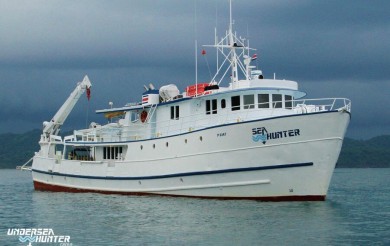Bighead Tilefish
Bighead Tilefish (Caulolatilus affinis)
Max. Length: 49.5 centimeters
Length at 1st Maturity: 25.3 centimeters
a value: 0.01230
b value: 3.000
Depth Range: 30 – 185 meters (100 – 610 feet)
Frequency: Abundant in the Eastern Pacific Ocean
If you happen to go deep diving in Cocos island and arrive in the sandy bottom, you will notice that there are medium-sized fish thriving in this deep-water ecosystem. Aside from their habitat, you can easily identify a bighead tilefish through its robust and quadrangular-shaped body that is colored olive green to blue grey with a dash of silver on the side and a broad yellow shade in front of its eyes.
As its name suggest, they have a big head. But not the big head that we know who is also hard-headed. Big head in the sense that their head-to-body ratio is relatively large compared to other species of tilefish. You will also notice that other body parts are big such as their lips and eyes.
Reef and Deep-Sea Inhabitant
Among the few species of fish in Cocos island that can be found in both the reef and deep-water ecosystem is the bighead tilefish. When you go deep diving and arrive at the sandy seafloor, like the ones that you will be exploring in Viking Rock, Punta Maria and Manuelita, you will see that a bighead tilefish can be found just a few meters off the reef. They may be solitary or can form loose aggregation.
While it is already deep for us, the sandy seafloor of the reef is just the start of its habitat range where they can be found further deep. This is manifested to their presence in Everest where some have seen them during a deep-sea submersible dive.
What is common in both of these interaction is that the presence of a bighead tilefish can only last for a few seconds, or may be up to a minute if you are lucky as they are highly shy. Your interaction with them starts by seeing them in a distance. They may come in close as they are intrigued by our presence underwater. But the moment you make your move towards them, this fish will never hesitate to swim away immediately as they consider you either as a threat or a mistaken predator.
Least Concern as of the Moment
While it may not be a real problem as far as Cocos island is concerned as its habitat is being protected by law, but in other countries, bighead tilefish are being harvested in huge quantity. Caught using both artisan and commercial fishing gears, fishermen target this particular fish due to its demand in the market where its meat is considered of good quality.
The wild population of bighead tilefish, for the meantime, can sustain the fishing pressure. However, as the demand for this fish continues to grow, there will come a time that its wild population will be threatened and may collapse. This is perfectly manifested when you go to the market and notice that the size of this fish continues to decrease as its wild population is being fished-out of the water long before it reaches maturity period.
Reference
Fishbase: www.fishbase.org
IUCN Redlist of Threatened Species: www.iucnredlist.org
Discover Life: www.discoverlife.org
You also might like these:
Cocos Island Liveaboard Trips for 2019
Due to high demand of liveaboard trips to Cocos island, as early as this year, we are publishing the 2019 trips for you to choose your preferred schedule and prepare for the ultimate diving adventure of your life. Reserve your seat to Cocos Island as they are selling like hotcakes. Schedule of Liveaboard Trip to […]















